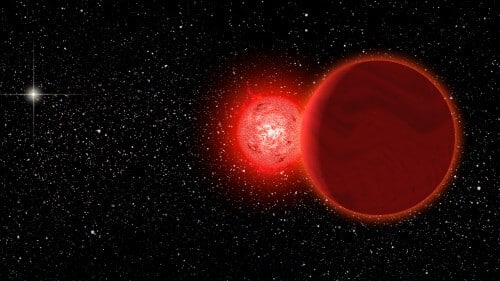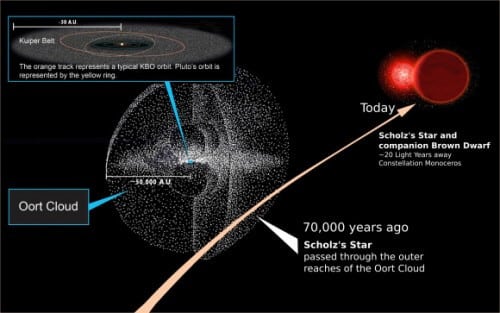Schulz's star - which is actually a pair of small stars, one a red dwarf and the other a brown dwarf - passed at a distance of 0.8 light years from the Sun, for comparison, the closest star to the Sun today is Proxima Centauri and it is 4.2 light years away from us. Today it is 20 light years away from us and continues to move away rapidly. Apparently his influence on the earth was negligible

Astronomers recently reported calculations according to which a pair of stars passed near the outermost regions of our solar system a total of 70 years ago, when the first humans began to walk the earth. The passage was apparently close enough to affect the orbits of comets in the Oort cloud, but Neanderthals and our Cro-Magnon ancestors were not in danger. However, now the astronomers are ready to examine whether other cases of this type have occurred.
Lead researcher Eric Mamaike of the University of Rochester and his colleagues reported in the Astrophysical Journal on the closest known transit of a star to our solar system and added that "the flyby likely caused negligible effects on the long-term orbit of comets. However, the current discovery of the pair of stars emphasizes the importance of the emission of comets from the Oort cloud during a close transit.
Schultz's star passed at a distance of 0.8 light years from the Sun, for comparison, the closest star to the Sun today is Proxima Centauri and it is 4.2 light years away from us.
While the internet is abuzz with conspiracy theories about a planet known as Nemesis approaching the inner solar system and somehow being hidden by NASA, the red dwarf and its companion represent the real thing.
In 1984, paleontologists David Raup and Jack Spekosky hypothesized that a dim dwarf star, popularly known as Nemesis, orbits the Sun in an extremely long orbit. They estimated that the star's orbit brings it close to the inner solar system once every 26 million years. This approach caused a shower of comets and mass extinctions during these periods. Not by coincidence but due to the high distribution of red dwarfs in the Milky Way, Scholz's star almost fits this scenario. The proposed Nemesis was supposed to be at a distance extending up to 95 thousand astronomical units, compared to Schultz's closest distance - 50 thousand astronomical units. (An astronomical unit is the distance between the earth and the sun - 150 million kilometers, a unit that has no meaning in itself but is used as a convenient means of describing distances in the solar system instead of using kilometers).
Recent studies regarding the rate of impact on the Earth, the Moon and Mars have reduced the likelihood of the existence of the planet Nemesis. However, Schultz's star - a real star that causes disruptions in the Oort cloud, is a star with spectral classification M9. M-type stars are the most common stars in our galaxy and probably in the entire universe, accounting for 75% of all stars. Schultz's mass is only 15% of that of the Sun. Schultz is a double star system where the second star system is a T5 brown dwarf. Brown dwarfs may also be found in abundance in the universe, but due to their obscuring brightness they are very difficult to detect, except, as in this case, when they accompany a brighter star.

The astronomers reported that they reviewed astronomical data of the stars near the Sun and identified Schultz as an interesting object. Its lateral velocity or the lateral velocity of the star is very low. In addition, they recognized that the radial velocity - the velocity towards us or away from us - was very fast. Schultz's star is moving directly away from the solar system. To know how close Schultz was to us in the past, they needed more accurate data.
For this purpose, the partners used two giant telescopes located in the southern hemisphere. at the Southern African Large Telescope (SALT) in DRAP and the Magellan Telescope at the Las Campanes Observatory in Chile. Now they could accurately measure the star's lateral and radial velocity and calculate its orbit taking into account the Sun's and Schultz's motion around the center of the galaxy.
The Shultz star is an active star that the researchers say that, despite its proximity, it shines at light level 11, an extremely dim light level, but eruptions on its surface may raise its brightness to a visible level and appear as a "new star" to the primitive humans of that time.
Today Shultz is about 20 light years away from us, but it is still one of the 70 closest stars to the solar system and yet the astronomers calculated, with 98% accuracy, that Shultz passed within half a light year or 50 thousand astronomical units from the Sun. Coincidentally, this distance of 50 thousand astronomical units symbolizes the outer limit of the Oort cloud where billions of comets float in a sort of cold warehouse, in an orbit that takes thousands of years to orbit the sun.
In light of the results of these calculations that indicate this approach, the co-authors of the article and other researchers are planning searches for additional "Nemesis" stars. The Large Synoptic Survey Telescope (LSST) and other telescopes that will operate in the next decade will provide a set of data that can help locate red dwarfs, brown dwarfs and possibly also 'orphan' planets floating in the near space. Some of them may trace past transits or future approaches of such stars to the Sun and Earth.

6 תגובות
Yehuda, Kobi is right. (at least in the case of a passing star)
To take a ride you don't have to chase it until you get it, as your words imply. And of course you don't have to collide with it for that matter... What you can do is plan a trajectory for the spaceship so that it will be in the right place and at the right time (and with the right velocity vector of course). The desired result is a deep enough entry into the transiting star's gravitational field, which will allow the spacecraft to perform a rocket maneuver or alternatively enter a stable orbit around the transiting star. In fact, this problem can be given as homework or a test question in Physics 1 to physics students! Great question.
To Kobe
To get on an asteroid, you have to reach the speed at which it moves in its orbit, so there is no energetic benefit in joining it.
interesting.
Kobi - In recent years, NASA has been trying to develop a special engine based on Alcubierre's solution to Einstein's equations. The engine is supposed to create a "bubble" around the spaceship, and blow it through space at least at the speed of light. If it works we won't need steroids/
http://www.nasa.gov/centers/glenn/technology/warp/warpstat_prt.htm
Not exactly, 20 light years in 70 thousand years is not a relevant speed for humans.
my father
The way to travel large distances in space is to take a ride on some large star or asteroid that enters and leaves the solar system.